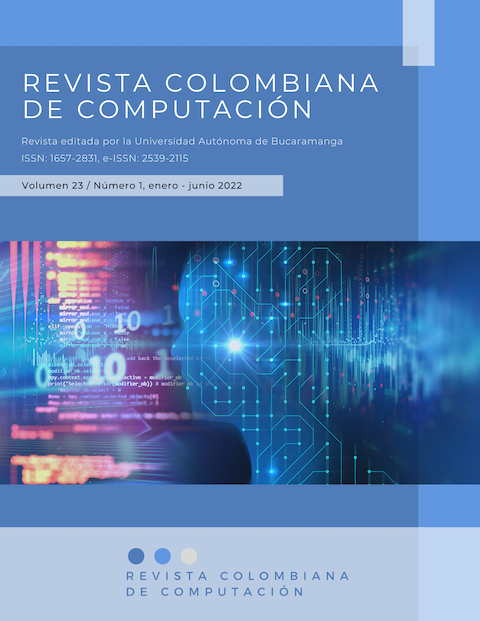IoT aplicado a sistemas de riego en agricultura: Un análisis de usabilidad
Resumen
El Internet de las Cosas favorece el aprovechamiento de las herramientas tecnológicas en ambientes rurales, gracias a la capacidad de conexión a Internet entre dispositivos que facilita el quehacer diario. El objetivo de la investigación es evaluar la usabilidad del sistema de soporte para la toma de decisiones de riego en el agro, AgroRIEGO, que se tiene desde el desarrollo de una aplicación de un dispositivo basado en IoT. El patrocinador de este proyecto fue el Ministerio de Tecnologías de Información y Comunicación y el Centro de Excelencia de Apropiación en Internet de las Cosas (CEA-IoT) en Colombia. Dentro de los métodos usados se encuentra el uso de la técnica de evaluación heurística, estructurada en 15 categorías y 62 subcategorías de valoración. Este análisis se complementa con el aporte de un grupo de expertos en el diseño y desarrollo de aplicaciones y dispositivos IoT y el agro para valorar los atributos del sistema.
Referencias bibliográficas
Agarwal, R., & Venkatesh, V. (2002). Assessing a firm’s Web presence: A heuristic evaluation procedure for the measurement of usability. Information Systems Research, 13(2), 168–186. https://doi.org/10.1287/isre.13.2.168.84
Bailey, D. R., Owen, J. S., Wagner, J., & Selker, J. S. (2013). In-situ performance and usability of a distributed, wireless sensor network via mesh connectivity at a production container nursery. Applied engineering in agriculture, 29(5), 779–782.
Bastien, J. M. C. (2010). Usability testing: a review of some methodological and technical aspects of the method. International Journal of Medical Informatics, 79(4), e18–e23. https://doi.org/10.1016/j.ijmedinf.2008.12.004
Blanck, P. (2014). Equality the struggle for web accessibility by persons with cognitive disabilities. In Equality the Struggle for Web Accessibility by Persons with Cognitive Disabilities. https://doi.org/10.1017/CBO9781107280151
Bright, L. F., Kleiser, S. B., & Grau, S. L. (2015). Too much Facebook? An exploratory examination of social media fatigue. Computers in Human Behavior, 44, 148–155. https://doi.org/10.1016/j.chb.2014.11.048
Caro, D, Romero-Riaño, E., Espinosa, A., & Guerrero, C. D. (2020). Evaluating usability contributions in ICT-IOT solutions for agriculture: A bibliometric perspective. RISTI - Revista Iberica de Sistemas e Tecnologias de Informacao, 2020(E28), 681–692.
Corneanu, C. A., Simón, M. O., Cohn, J. F., & Guerrero, S. E. (2016). Survey on RGB, 3D, Thermal, and Multimodal Approaches for Facial Expression Recognition: History, Trends, and Affect-Related Applications. IEEE Transactions on Pattern Analysis and Machine Intelligence, 38(8), 1548–1568. https://doi.org/10.1109/TPAMI.2016.2515606
D’mello, S. K., & Kory, J. (2015). A Review and Meta-Analysis of Multimodal Affect Detection Systems. ACM Computing Surveys, 47(3), 1–36. https://doi.org/10.1145/2682899
Flandoli, A. M. B., & Romero-Riaño, E. (2020). The Role of Gamification in the Environmental Awareness: A Bibliometric Review Intellectual Structure Evolution. In Prisma Social (Issue 30).
Garmer, K., Liljegren, E., Osvalder, A. L., & Dahlman, S. (2002). Application of usability testing to the development of medical equipment. Usability testing of a frequently used infusion pump and a new user interface for an infusion pump developed with a human factors approach. International Journal of Industrial Ergonomics, 29(3), 145–159. https://doi.org/10.1016/S0169-8141(01)00060-9
Gil-Quintana, J., Santoveña-Casal, S., & Riaño, E. R. (2021). Realfooders influencers on instagram: From followers to consumers. International Journal of Environmental Research and Public Health, 18(4). https://doi.org/10.3390/ijerph18041624
Granollers, T. (2018). Usability Evaluation with Heuristics. New Proposal from Integrating Two Trusted Sources 2 Combining Common Heuristic Sets. 1–16.
Guerrero, C. D., & Rico-Bautista, D. (2020). Center for excellence and internet acquisition of things: A commitment to competitiveness from alliances between government, academia and productive sector. RISTI - Revista Iberica de Sistemas e Tecnologias de Informacao, 2020(E28), 615–628.
Hornbæk, K. (2006). Current practice in measuring usability: Challenges to usability studies and research. International Journal of Human Computer Studies, 64(2), 79–102. https://doi.org/10.1016/j.ijhcs.2005.06.002
Huggins, J. E., Guger, C., Ziat, M., Zander, T. O., Taylor, D., Tangermann, M., Soria-Frisch, A., Simeral, J., Scherer, R., Rupp, R., Ruffini, G., Robinson, D. K. R., Ramsey, N. F., Nijholt, A., Mueller-Putzo, G., McFarland, D. J., Mattia, D., Lancer, B. J., Kindermans, P.-J., … Aarnoutse, E. J. (2017). Workshops of the Sixth International Brain-Computer Interface Meeting: braincomputer interfaces past, present, and future. Brain-Computer Interfaces, 4(1–2, SI), 3–36. https://doi.org/10.1080/2326263X.2016.1275488
Nielsen, J. (1994). Usability Engineering.
Kantner, L., & Rossenabum, S. (1997). Usability Studies of WWW Sites:Heuristic Evaluation vs. Laboratory Testing. ACM International Conference on Interactive Tabletops and Surfaces, ITS 2010.
Kowalczewska, K., & Turnhout, E. (2012). The Usability of Scenario Studies: the Case of the EUruralis from the Users’ Perspective. Polish Sociological Review, 177, 91–105.
Maguire, M. (2001). Methods to support human-centred design. International Journal of Human Computer Studies, 55(4), 587–634. https://doi.org/10.1006/ijhc.2001.0503
Martinez-Toro, G. M., Ariza-Zabala, G. C., Rico-Bautista, D., & Romero-Riaño, E. (2019). Human computer interaction in transport, a systematic literature review. Journal of Physics: Conference Series, 1409, 012002. https://doi.org/10.1088/1742-6596/1409/1/012002
McIntire, J. P., Havig, P. R., & Geiselman, E. E. (2014). Stereoscopic 3D displays and human performance: A comprehensive review. Displays, 35(1), 18–26. https://doi.org/10.1016/j.displa.2013.10.004
Parra Valencia, J. A., Guerrero, C. D., & Rico-Bautista, D. (2017). IOT: una aproximación desde ciudad inteligente a universidad inteligente. Revista Ingenio, 13(1), 9–20. https://doi.org/10.22463/2011642X.2128
Rau, P. L. P., & Liang, S. F. M. (2003). Internationalization and localization: Evaluating and testing a Website for Asian users. Ergonomics, 46(1–3), 255–270. https://doi.org/10.1080/00140130303527
Rautaray, S. S., & Agrawal, A. (2012). Vision based hand gesture recognition for human computer interaction: a survey. Artificial Intelligence Review, 43(1), 1–54. https://doi.org/10.1007/s10462-012-9356-9
Rico-Bautista, D., Collazos, C. A., Guerrero, C. D., Maestre-Gongora, G., & Medina-Cárdenas, Y. (2021). Latin American Smart University: Key Factors for a User-Centered Smart Technology Adoption Model. In Sustainable Intelligent Systems (pp. 161–173). https://doi.org/10.1007/978-981-33-4901-8_10
Rico-Bautista, D., Maestre-Gongora, G., & Guerrero, C. D. (2020). Smart University:IoT adoption model. 2020 Fourth World Conference on Smart Trends in Systems, Security and Sustainability (WorldS4), 821–826. https://doi.org/10.1109/WorldS450073.2020.9210369
Rico-Bautista, D., Medina-Cárdenas, Y., & Guerrero, C. D. (2019). Smart University: A Review from the Educational and Technological View of Internet of Things. In P. M., F. C., & R. A. (Eds.), International Conference on Information Technology and Systems, ICITS 2019 (Vol. 918, pp. 427–440). Springer Verlag. https://doi.org/10.1007/978-3-030-11890-7_42
Romero-Riaño, E., Guerrero-Santander, C. D., & Martínez-Ardila, H. E. (2021). Agronomy research co-authorship networks in agricultural innovation systems. Revista UIS Ingenierías, 20(1), 161–175. https://doi.org/10.18273/revuin.v20n1-2021015
Seufert, M., Egger, S., Slanina, M., Zinner, T., Hossfeld, T., & Tran-gia, P. (2015). A Survey on Quality of Experience of HTTP Adaptive Streaming. Ieee Communication Surveys & Tutorials, 17(1), 469–492. https://doi.org/10.1109/COMST.2014.2360940
Turk, M. (2014). Multimodal interaction: A review. Pattern Recognition Letters, 36(1), 189–195. https://doi.org/10.1016/j.patrec.2013.07.003
Waytz, A., Heafner, J., & Epley, N. (2014). The mind in the machine: Anthropomorphism increases trust in an autonomous vehicle. Journal of Experimental Social Psychology, 52, 113–117. https://doi.org/10.1016/j.jesp.2014.01.005












